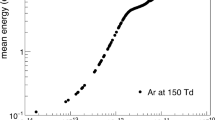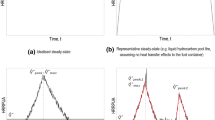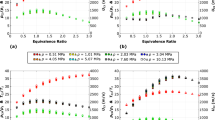Abstract
This paper proposes novel modifications to existing solid flame and point source models to better predict the spatial contour of near-field, steady-state radiant heat flux from large circular pool fires (with diameters ranging from 1 m to 20 m) with gasoline and diesel fuel. The proposed models account for partial smoke obscuration of the flames, and the emissive power of the visible flame layer is calculated via a radiative fraction of the fire’s heat release rate as a function of the pool size. The modified discretized solid flame model uses a cylinder + cone shape combination whose surfaces are discretized to enable a flexible summation of total radiative energy emission. The modified point source model places its radiating point at the mid-height of the visible flame layer to capture the location of maximum radiation intensity. Predictions from both proposed models are benchmarked against available data from pool fire experiments, calibrated against computational fluid dynamic simulations, and compared with existing analytical solutions for a range of pool fire diameters at varying standoffs and gauge heights. The results demonstrate that the proposed models can effectively predict the spatial contour and peak value of radiant heat flux on nearby targets (i.e., at distances less than 2.5 times the pool diameter) with low computational effort.














Similar content being viewed by others
Data Availability
Data pertaining to this study is available from the authors upon request, including input files for FDS analyses as well as numeric output from the proposed models.
Change history
06 March 2021
The citation of the figures in the context and order of figures has been corrected now.
References
Babrauskas V (1983) Estimating large pool fire burning rates. Fire Technol 19:251–261. https://doi.org/10.1007/BF02380810
US HUD (2020), Acceptable separation distance guidebook, US Department of Housing and Urban Development, Washington, D.C., 2020. Accessed from 21 May 2020 https://www.hud.gov/sites/documents/HUD-GUIDEBOOK.PDF
Cheng H, Hadjisophocleous GV (2012) Experimental study and modeling of radiation from compartment fires to adjacent buildings. Fire Saf J 53:43–62. https://doi.org/10.1016/j.firesaf.2012.06.005
S. Quiel, T. Yokoyama, K. Mueller, L. Bregman, S. Marjanishvili (2015) Mitigating the effects of a tanker truck fire on a cable-stayed bridge. In: proceedings of the second international conference on performance-based and life-cycle structural engineering (PLSE 2015), 2015: 1002–1012. https://doi.org/https://doi.org/10.14264/uql.2016.539.
Quiel SE, Yokoyama T, Bregman LS, Mueller KA, Marjanishvili SM (2015) A streamlined framework for calculating the response of steel-supported bridges to open-air tanker truck fires. Fire Saf J 73:63–75. https://doi.org/10.1016/j.firesaf.2015.03.004
Santos FDS, Landesmann A (2014) Thermal performance-based analysis of minimum safe distances between fuel storage tanks exposed to fire. Fire Saf J 69:57–68. https://doi.org/10.1016/j.firesaf.2014.08.010
Iqbal N, Salley MH (2004) NUREG-1805: Fire Dynamics Tools (FDTs): Quantitative fire hazard analysis methods for the U.S. nuclear regulatory commission fire protection inspection program, US Nuclear Regulatory Commission, Washington, D.C. https://www.nrc.gov/docs/ML0432/ML043290075.pdf.
Siu NO, Melly N, Nowlen SP, Kazarians M (2016) Chapter 89: Fire risk analysis for nuclear power plants. In: Hurley MJ et al (eds) SFPE handbook of fire protection engineering. Springer, New York, NY. https://doi.org/10.1007/978-1-4939-2565-0_89
Niazi UM, Nasif MS, Bin Muhammad M, Imran M (2016) Modeling of pool fire and injury prediction considering different wind speeds and directions in offshore platform. ARPN J Eng Appl Sci 11:13000–13005
Bin Ding L, Pu JY, Ren K (2014) Analysis of thermal radiation models for large open pool fire on ship deck. Appl Mech Mater. 470: 259–262. https://doi.org/https://doi.org/10.4028/www.scientific.net/AMM.470.259
Kent JH (1986) A quantitative relationship between soot yield and smoke point measurements. Combust Flame 63:349–358. https://doi.org/10.1016/0010-2180(86)90004-0
McGrattan KB, Baum HR, Hamins A (2000) NISTIR 6546: thermal radiation from large pool fires. National Institute of Standards and Technology, Gaithersburg, MD. https://doi.org/10.6028/NIST.IR.6546
Muñoz M, Arnaldos J, Casal J, Planas E (2004) Analysis of the geometric and radiative characteristics of hydrocarbon pool fires. Combust Flame 139:263–277. https://doi.org/10.1016/j.combustflame.2004.09.001
Muñoz M, Planas E, Ferrero F, Casal J (2007) Predicting the emissive power of hydrocarbon pool fires. J Hazard Mater 144:725–729. https://doi.org/10.1016/j.jhazmat.2007.01.121
Beyler CL (2016) Fire hazard calculations for large, open hydrocarbon fires. In: Hurley MJ et al (eds) SFPE handbook of fire protection engineering. Springer, New York, NY. https://doi.org/10.1007/978-1-4939-2565-0_66
McGrattan K, McDermott R, Hostikka S, Floyd J (2013) NIST SP 1019: Fire Dynamics Simulator (Version 6) user’s guide. National Institute of Standards and Technology, Gaithersburg, MD
Li YZ, Huang C, Anderson J, Svensson R, Ingason H, Husted B, Runefors M (2017) Wahlqvist, Verification, validation and evaluation of FireFOAM as a tool for performance design, Lund University, Lund, Sweden. Accessed from 22 May 2020 http://www.diva-portal.org/smash/get/diva2:1166638/FULLTEXT01.pdf
Babrauskas V (2016) Chapter 26: Heat release rates. SFPE handbook of fire protection engineering, 5th edn. Society of Fire Protection Engineering, New York, NY, pp 799–904
Gottuk DT, White DA (2016) Chapter 65: liquid fuel fires. SFPE handbook of fire protection engineering, 5th edn. Society of Fire Protection Engineering, New York, NY, pp 2552–2590
Heskestad G (2016) Fire plumes, flame height, and air entrainment. In: Hurley MJ et al (eds) SFPE handbook of fire protection engineering. Springer, New York, NY. https://doi.org/10.1007/978-1-4939-2565-0_13
Heskestad G (1983) Luminous heights of turbulent diffusion flames. Fire Saf J 5:103–108. https://doi.org/10.1016/0379-7112(83)90002-4
Thomas PH (1963) The size of flames from natural fires. Symp (Int) Combust 9:844–859. https://doi.org/10.1016/S0082-0784(63)80091-0
Drysdale D (2011) An introduction to fire dynamics, 3rd edn. Wiley, Chichester. https://doi.org/10.1002/9781119975465
Modak AT (1977) Thermal radiation from pool fires. Combust Flame 29:177–192. https://doi.org/10.1016/0010-2180(77)90106-7
Wang X, Fan Y, Zhou K, Yu Y (2018) Multi-layer cylindrical flame model for predicting radiant heat flux from pool fire. Procedia Engineering 211:768–777. https://doi.org/10.1016/j.proeng.2017.12.074
Shokri M, Beyler CL (1989) Radiation from large pool fires. J Fire Prot Eng 1:141–149. https://doi.org/10.1177/104239158900100404
Mudan KS (1984) Thermal radiation hazards from hydrocarbon pool fires. Prog Energy Combust Sci 10:59–80. https://doi.org/10.1016/0360-1285(84)90119-9
Ufuah E, Bailey CG (2011) Flame radiation characteristics of open hydrocarbon pool fires. In: Proceedings of the World Congress on Engineering, London, UK
Planas-Cuchi E, Chatris JM, López C, Arnaldos J (2003) Determination of flame emissivity in hydrocarbon pool fires using infrared thermography. Fire Technol 39:261–273. https://doi.org/10.1023/A:1024193515227
Raj VC, Prabhu SV (2018) Measurement of geometric and radiative properties of heptane pool fires. Fire Saf J 96:13–26. https://doi.org/10.1016/j.firesaf.2017.12.003
Sudheer S, Prabhu SV (2012) Measurement of flame emissivity of hydrocarbon pool fires. Fire Technol 48:183–217. https://doi.org/10.1007/s10694-010-0206-5
Sudheer S, Prabhu SV (2013) Characterization of hexane pool fires using infrared thermography. J Fire Sci 31:143–165. https://doi.org/10.1177/0734904112459260
Sudheer S, Prabhu SV (2010) Measurement of flame emissivity of gasoline pool fires. Nucl Eng Des 240:3474–3480. https://doi.org/10.1016/j.nucengdes.2010.04.043
Koseki H, Yumoto T (1988) Air entrainment and thermal radiation from heptane pool fires. Fire Technol 24:33–47. https://doi.org/10.1007/BF01039639
Raj PK (2007) Large hydrocarbon fuel pool fires: physical characteristics and thermal emission variations with height. J Hazard Mater 140:280–292. https://doi.org/10.1016/j.jhazmat.2006.08.057
Zhou K, Liu N, Zhang L, Satoh K (2014) Thermal radiation from fire whirls: revised solid flame model. Fire Technol 50:1573–1587. https://doi.org/10.1007/s10694-013-0360-7
Shen G, Zhou K, Wu F, Jiang J, Dou Z (2019) A model considering the flame volume for prediction of thermal radiation from pool fire. Fire Technol 55:129–148. https://doi.org/10.1007/s10694-018-0779-y
Zhu Z, Quiel SE, Carlton A, Mueller KA, Marjanishvili SM (2020) Performance-based prioritisation of fire protection for steel girder overpasses in a complex highway interchange. Struct Infrastruct Eng 16:394–411. https://doi.org/10.1080/15732479.2019.1666884
Guo Q, Root KJ, Carlton A, Quiel SE, Naito CJ (2019) Framework for rapid prediction of fire-induced heat flux on concrete tunnel liners with curved ceilings. Fire Saf J 109:102866. https://doi.org/10.1016/j.firesaf.2019.102866
Manco MR, Vaz MA, Cyrino JCR, Landesmann A (2018) Ellipsoidal solid flame model for structures under localized fire. Fire Technol 54:1505–1532. https://doi.org/10.1007/s10694-018-0750-y
Quiel SE, Zhu Z (2019) Numerical evaluation of a sample steel girder bridge for a construction trailer fire underneath (ATLSS Report No. 18–03). Advanced Technology for Large Structural Systems (ATLSS) Engineering Research Center, Bethlehem, PA. https://doi.org/10.13140/RG.2.2.33593.52321/1
Wen JX, Kang K, Donchev T, Karwatzki JM (2007) Validation of FDS for the prediction of medium-scale pool fires. Fire Saf J 42:127–138. https://doi.org/10.1016/j.firesaf.2006.08.007
Zadeh SE, Beji T, Merci B (2016) Assessement of FDS 6 simulation results for a large-scale ethanol pool fire. Combust Sci Technol 188:571–580. https://doi.org/10.1080/00102202.2016.1139367
Ryder NL, Sutula JA, Schemel CF, Hamer AJ, Brunt VV (2004) Consequence modeling using the fire dynamics simulator. J Hazard Mater 115:149–154. https://doi.org/10.1016/j.jhazmat.2004.06.018
McGrattan K, Floyd J, Forney G, Baum H, Hostikka S (2003) Improved radiation and combustion routines for a large eddy simulation fire model. Fire Safety Sci 7:827–838. https://doi.org/10.3801/IAFSS.FSS.7-827
Skarsbø LR (2011) An experimental study of pool fires and validation of different CFD fire models. Department of Physics and Technology University of Bergen, Bergen
Sudheer S, Saumil D, Prabhu SV (2013) Physical experiments and Fire Dynamics Simulator simulations on gasoline pool fires. J Fire Sci 31:309–329. https://doi.org/10.1177/0734904112472953
Sun B, Guo K, Pareek VK (2014) Computational fluid dynamics simulation of LNG pool fire radiation for hazard analysis. J Loss Prev Process Ind 29:92–102. https://doi.org/10.1016/j.jlp.2014.02.003
S. Schalike, K. Wehrstedt, A. Schonbucher (2011) CFD simulation to predict the thermal radiation of large LNG pool fires, In: Proceedings of the European Combustion Meeting 2011, Cardiff, UK
Sedano CA, López OD, Ladino A, Muñoz F (2017) Prediction of a Small-Scale Pool Fire with FireFoam. Int J Chem Eng. https://doi.org/10.1155/2017/4934956
McGrattan K (2007) NUREG-1824: Verification and validation of selected fire models for nuclear power plant applications, Volume 7: Fire Dynamics Simulator (FDS), US Nuclear Regulatory Commission, Washington, D.C. https://www.nrc.gov/docs/ML0717/ML071730543.pdf.
Hostikka S, Mcgrattan K, Hamins A (2003) Numerical modeling of pool fires using les and finite volume method for radiation. Fire Safety Sci 7:383–394. https://doi.org/10.3801/IAFSS.FSS.7-383
Ahmadi O, Mortazavi SB, Pasdarshahri H, Mohabadi HA (2019) Consequence analysis of large-scale pool fire in oil storage terminal based on computational fluid dynamic (CFD). Process Saf Environ Prot 123:379–389. https://doi.org/10.1016/j.psep.2019.01.006
Sjostrom J, Appel G, Amon F, Persson H (2015) ETANKFIRE–Experimental results of large ethanol fuel pool fires (SP Report 2015:12), SP Technical Research Institute of Sweden, Boras, Sweden, 2015. http://ri.diva-portal.org/smash/get/diva2:962885/FULLTEXT01.pdf
Zhou K, Liu N, Lozano JS, Shan Y, Yao B, Satoh K (2013) Effect of flow circulation on combustion dynamics of fire whirl. Proc Combust Inst 34:2617–2624. https://doi.org/10.1016/j.proci.2012.06.053
Zukoski EE, Cetegen BM, Kubota T (1985) Visible structure of buoyant diffusion flames. Symposium Int Combust 20:361–366. https://doi.org/10.1016/S0082-0784(85)80522-1
The MathWorks Inc (2017) MATLAB and Statistics Toolbox. Natick, Massachussetts
Sudheer S (2013) Characterization of open pool fires and study of heat transfer in bodies engulfed in pool fires, PhD Dissertation, Indian Institute of Technology Bombay
Koseki H (1989) Combustion properties of large liquid pool fires. Fire Technol 25:241–255. https://doi.org/10.1007/BF01039781
Sibulkin M (1973) Estimates of the effect of flame size on radiation from fires. Combust Sci Technol 7:141–143. https://doi.org/10.1080/00102207308952352
Koseki H (2000) Large scale pool fires: results of recent experiments. Fire Safety Sci 6:115–132. https://doi.org/10.3801/IAFSS.FSS.6-115
Hurley MJ (2016) Appendix 3: fuel properties and combustion data. In: Hurley MJ (ed) SFPE Handbook of Fire Protection Engineering, 5th edn. Society of Fire Protection Engineering, New York, NY, pp 3437–3475
Lin C-H, Ferng Y-M, Hsu W-S, Pei B-S (2010) Investigations on the characteristics of radiative heat transfer in liquid pool fires. Fire Technol 46:321–345. https://doi.org/10.1007/s10694-008-0071-7
Forney GP (2007) NIST SP 1017–1: User’s guide for smokeview version 5—a tool for visualizing fire dynamics simulation data. National Institute of Standards and Technology, Gaithersburg, MD
McGrattan K, Toman B (2011) Quantifying the predictive uncertainty of complex numerical models. Metrologia 48:173–180. https://doi.org/10.1088/0026-1394/48/3/011
Paudel D, Hostikka S (2019) Propagation of model uncertainty in the stochastic simulations of a compartment fire. Fire Technol 55:2027–2054. https://doi.org/10.1007/s10694-019-00841-9
Acknowledgements
Financial support for Dr. Zhu’s involvement in this project as a doctoral research assistant was provided by Lehigh University via Professor Quiel’s faculty startup fund. Additional support for Dr. Zhu’s involvement in this project as a postdoctoral research associate was provided by the U.S. Department of Transportation (Grant #69A3551747118) via the University Transportation Center for Underground Transportation Infrastructure (UTC-UTI) at the Colorado School of Mines. The opinions expressed in this paper are the authors’ and not that of the US DOT, UTC-UTI, or Lehigh University.
Author information
Authors and Affiliations
Contributions
Both authors were involved in all aspects of this study and the development of this paper.
Corresponding author
Ethics declarations
Conflict of interest
The authors have no conflicts of interest to declare.
Additional information
Publisher's Note
Springer Nature remains neutral with regard to jurisdictional claims in published maps and institutional affiliations.
Rights and permissions
About this article
Cite this article
Zhu, Z., Quiel, S.E. Near-Field Radiant Heat Flux from Open-Air Gasoline and Diesel Pool Fires: Modified Point Source and Discretized Solid Flame Models. Fire Technol 57, 1901–1926 (2021). https://doi.org/10.1007/s10694-021-01097-y
Received:
Accepted:
Published:
Issue Date:
DOI: https://doi.org/10.1007/s10694-021-01097-y




